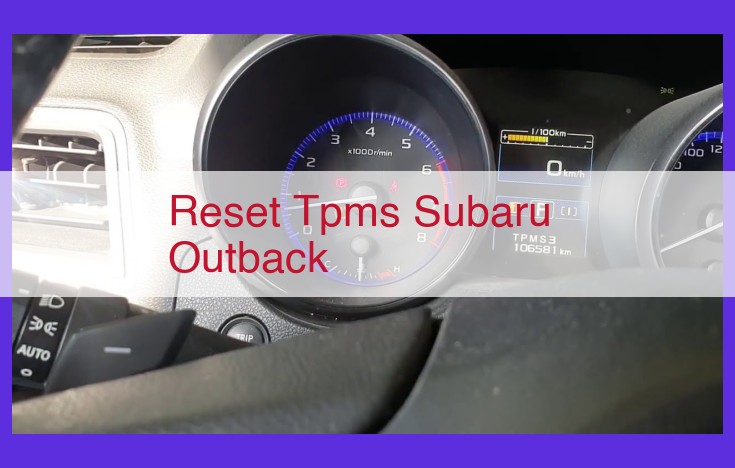How To Reset Your Subaru Outback Tire Pressure Monitoring System (Tpms) For Optimal Performance
Resetting the Tire Pressure Monitoring System (TPMS) on a Subaru Outback is necessary after adjusting tire pressure to ensure accurate pressure readings and optimal performance. To reset the TPMS, locate the reset button, activate it, engage the parking brake, shift into park, and start the engine. The TPMS sensors will activate and the system will reset. If the button method fails, consider using a TPMS tool. Monitor the tire pressure warning light to ensure the TPMS is functioning correctly. Regular tire inspections are also crucial for maintaining safety and performance.
Understanding the TPMS System: A Crucial Tool for Road Safety and Vehicle Performance
A Tire Pressure Monitoring System (TPMS) is an essential safety feature in modern vehicles that plays a pivotal role in enhancing road safety and optimizing vehicle performance. It’s a system composed of tire pressure sensors that continuously monitor the inflation levels of each tire and transmit the data to the dashboard. This real-time monitoring helps you identify any discrepancies in tire pressure, enabling you to take prompt action and prevent potential tire failures.
By ensuring proper tire inflation, a TPMS helps maintain vehicle stability and handling, which directly impacts road safety. It also contributes to fuel efficiency, as underinflated or overinflated tires can increase rolling resistance and reduce fuel economy. Furthermore, it extends tire life by preventing premature wear and tear caused by incorrect tire pressure.
The Crucial Importance of TPMS Reset: Keeping Your Tires in Check
Imagine driving down the highway, feeling confident in your vehicle’s performance. But what if an unseen threat is lurking beneath the surface of your tires? Underinflated tires can significantly compromise safety and hinder your car’s ability to perform at its best. That’s where the Tire Pressure Monitoring System (TPMS) steps in, acting as a vigilant sentinel, constantly monitoring tire pressure and alerting you to any deviations.
However, after adjusting your tire pressure, whether due to a flat repair or seasonal changes, it’s crucial to reset the TPMS system. This seemingly simple task plays a vital role in ensuring accurate pressure readings and maintaining optimal vehicle performance.
The TPMS reset synchronizes the system with the newly adjusted pressure levels. Without this reset, the sensors may continue to display outdated information, potentially masking any underlying issues with tire pressure. This can lead to a false sense of security, putting you at risk of underinflated tires.
Properly inflated tires not only enhance safety but also provide several other benefits:
- Improved traction and handling: Tires with the correct pressure provide better grip on the road, contributing to more precise and controlled vehicle handling.
- Reduced rolling resistance: Underinflated tires increase rolling resistance, resulting in higher fuel consumption. Resetting your TPMS helps ensure optimal fuel efficiency.
- Increased tire lifespan: Underinflation can cause uneven wear and premature aging of tires, reducing their overall lifespan. Regular TPMS resets help prevent this by maintaining proper pressure levels.
Resetting your TPMS is a simple and straightforward process. However, the specific procedure may vary depending on your vehicle’s make and model. Consult your vehicle’s owner’s manual or refer to reliable online resources for specific instructions. By following these steps diligently, you can ensure accurate pressure readings, optimal tire performance, and a safer driving experience.
Step-by-Step TPMS Reset Procedure
Ensuring accurate tire pressure readings is crucial for optimal vehicle performance and safety. This is where Tire Pressure Monitoring Systems (TPMS) come into play. When adjusting tire pressure, a TPMS reset becomes essential to recalibrate the system and provide precise pressure readings.
To begin the TPMS reset process, carefully check the tire pressure using a gauge. Ensure that the pressure matches the manufacturer’s recommendations for your vehicle.
Next, locate the TPMS reset button. This button’s position varies depending on the vehicle but is typically found under the dashboard, on the center console, or within the glove compartment. Consult your vehicle’s owner’s manual for specific instructions.
Once the reset button is located, engage the parking brake, shift the vehicle into park, and start the engine. This action will activate the TPMS sensors, allowing them to receive and transmit pressure readings.
Now, press and hold the TPMS reset button for the specified duration, as outlined in your vehicle’s manual. The duration varies between vehicles, so it’s crucial to refer to the manufacturer’s instructions. Typically, the system will emit a series of beeps or flashes to indicate that the reset has been successful.
Note: If the reset button method fails to work, it may be necessary to use a dedicated TPMS tool. These tools are designed specifically for TPMS reset and can be purchased at most automotive repair centers or online.
Troubleshooting and Additional Tips for TPMS Reset
Situations Where the Reset Button Method Might Not Work
If the reset button method fails to reset your TPMS, you may need to use a TPMS tool. These tools are specifically designed to work with your vehicle’s TPMS system and can be purchased at auto parts stores.
Interpreting the Tire Pressure Warning Light
Your *TPMS warning light will illuminate when the system detects a significant drop in tire pressure. This light is crucial in alerting you to potential tire issues that need attention. The status of this light can provide valuable insights:
- Blinking: Indicates a temporary loss of communication with a tire pressure sensor.
- Solid illumination: Signals a significant decrease in tire pressure and requires prompt action.
Regular Tire Inspections for Optimal Performance
Regularly inspecting your tires is essential for maintaining optimal performance and safety. Check the tire pressure using a gauge to ensure it aligns with the specifications recommended by your vehicle’s manufacturer. Look for any signs of damage, such as punctures, cuts, or bulges.
